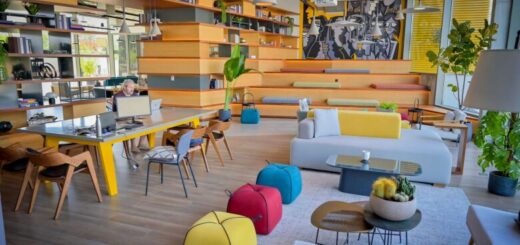Exploring Dubai’s Old Quarter: A Journey through History and Culture
When most people think of Dubai, they envision the glitzy skyscrapers, luxury shopping, and extravagant lifestyle that the city is famous for. While these modern marvels are indeed captivating, Dubai has a hidden gem that offers a stark contrast to the futuristic cityscape – the Old Quarter, often referred to as Al Bastakiya or Al Fahidi Historic District.

This historic neighborhood is a step back in time, where you can experience the city’s rich cultural heritage and a more traditional way of life. Here’s a guide to the best things to see and do in Dubai’s Old Quarter.
Best Things To See And Do in Dubai’s Old Quarter.
Al Fahidi Fort:

Start your journey through Dubai’s past at Al Fahidi Fort, which houses the Dubai Museum. This beautifully restored fort dates back to 1787 and is one of the oldest buildings in the city. Inside, you’ll find a captivating collection of artifacts, photographs, and interactive exhibits that provide insights into Dubai’s transformation from a fishing and pearling village to a global metropolis. The fort itself is a masterpiece of traditional Arabian architecture.
Al Bastakiya:

Wander through the labyrinthine lanes of Al Bastakiya, a historic district known for its traditional wind-tower architecture. The narrow, winding alleyways, adorned with whitewashed buildings, are a testament to Dubai’s architectural roots. The district is also home to numerous art galleries and cultural centers, making it an excellent place to explore local and regional art.
Art Galleries:

Dubai’s Old Quarter is a hub for the art community. Numerous art galleries and studios can be found throughout the district, showcasing a wide range of contemporary and traditional art. One of the most renowned is the XVA Gallery, which features local and international artists and often hosts exhibitions and art-related events.
Traditional Architecture:

While wandering through Al Bastakiya, take a moment to appreciate the traditional Arabian architecture. The iconic wind towers, known as “barajeel,” are architectural marvels designed to capture and channel the breeze to keep the buildings cool during the scorching summers. The contrast between the old architecture and the modern skyscrapers in the distance is a visual treat.
Al Fahidi Souk:

Embrace the spirit of the old souks at Al Fahidi Souk, a vibrant and bustling market where you can shop for traditional Arabian goods, such as spices, textiles, perfumes, and jewelry. The souk’s narrow streets and bustling stalls provide a glimpse into the trading culture of old Dubai.
Coffee Museum:

For coffee enthusiasts, the Coffee Museum in the Old Quarter is a must-visit. It’s a small but informative museum that delves into the history of coffee and its cultural significance in the Middle East. You can enjoy a cup of traditional Arabic coffee while you learn about its origins.
Dubai Heritage Village:

Immerse yourself in the heritage and traditions of Dubai at the Heritage Village. This outdoor museum showcases the traditional way of life in the Emirates, with live demonstrations of pottery, metalwork, and other crafts. You can also explore a replica of an old Emirati village, complete with a mosque and a traditional majlis (sitting area).
Al Serkal Cultural Foundation:

The Al Serkal Cultural Foundation is a hub for cultural activities in the Old Quarter. It hosts art exhibitions, workshops, and performances that celebrate Emirati and Middle Eastern cultures. Check their schedule for events and performances during your visit.
Arabian Tea House:

Indulge in traditional Emirati and Middle Eastern cuisine at the Arabian Tea House, a quaint restaurant nestled in the heart of Al Bastakiya. The restaurant’s courtyard and interior are decorated in traditional style, creating a truly immersive dining experience.
Dubai Creek:

Conclude your visit by taking a traditional abra (wooden water taxi) ride across Dubai Creek. The creek is the historic lifeline of the city and a reminder of Dubai’s maritime heritage. As you glide across the water, you’ll see a contrast between the old and new Dubai, with modern skyscrapers in the distance.
Dubai’s Old Quarter is a treasure trove of history, culture, and art, offering a unique perspective on the city’s past and present. It’s a place where time seems to stand still amidst the fast-paced, contemporary world of Dubai. Whether you’re a history buff, an art lover, or simply curious about the heritage of this dynamic city, a visit to the Old Quarter is an enriching experience that you won’t want to miss.
FAQs
What is Dubai’s Old Quarter, and where is it located?
Dubai’s Old Quarter, also known as Al Bastakiya or Al Fahidi Historic District, is a historic neighborhood in the heart of Dubai, United Arab Emirates. It’s situated on the western side of Dubai Creek, providing a glimpse into the city’s rich cultural heritage and traditional way of life.
What are the top attractions to see in Dubai’s Old Quarter?
Some of the top attractions in Dubai’s Old Quarter include Al Fahidi Fort (home to the Dubai Museum), Al Bastakiya’s historic architecture, art galleries, Al Fahidi Souk, the Coffee Museum, Dubai Heritage Village, the Al Serkal Cultural Foundation, the Arabian Tea House, and Dubai Creek.
How can I get to Dubai’s Old Quarter?
You can reach Dubai’s Old Quarter by various means of transportation. If you’re in the newer parts of Dubai, you can take a taxi, ride-sharing service, or the Dubai Metro to get to the Old Quarter. It’s also accessible by traditional wooden abras (water taxis) from the Deira side of Dubai Creek.
Are there guided tours available for exploring Dubai’s Old Quarter?
Yes, guided tours of the Old Quarter are readily available. Many tour operators offer walking tours that provide historical and cultural insights into the neighborhood. These tours often include visits to key attractions, such as the Dubai Museum and art galleries, and offer a deeper understanding of the area’s significance.
What is the best time to visit Dubai’s Old Quarter?
The best time to visit the Old Quarter is during the cooler months, which typically run from November to March. The weather is more pleasant during this period, making it easier to explore the area on foot. Avoid the scorching summer months when temperatures can become unbearably hot.
Is there an entrance fee to visit attractions in Dubai’s Old Quarter?
There is an entrance fee to access the Dubai Museum, located within Al Fahidi Fort. Prices may vary depending on your age and nationality. Most other attractions in the area, such as the art galleries and the Al Serkal Cultural Foundation, are often free of charge.
Can I take photographs in the Old Quarter?
In general, photography is permitted in most parts of the Old Quarter, but it’s essential to be respectful of local customs and privacy. Some art galleries may have restrictions on photography, so it’s a good idea to ask for permission before taking pictures inside.
What is the significance of the wind towers in Al Bastakiya?
The wind towers, known as “barajeel,” are a hallmark of traditional Arabian architecture. They were designed to capture and channel the breeze, providing natural cooling to the buildings during the hot summers. These towers are not only functional but also an architectural marvel, and they showcase the ingenuity of the builders.
Can I purchase souvenirs and traditional items in the Old Quarter?
Yes, you can shop for a variety of traditional Arabian goods, spices, textiles, perfumes, jewelry, and more at Al Fahidi Souk and other small shops in the Old Quarter. It’s an excellent place to find unique souvenirs and local products.
Is there a dress code for visiting the Old Quarter?
While there isn’t a strict dress code for the Old Quarter, it’s recommended to dress modestly out of respect for the local culture and traditions. Wearing conservative clothing that covers the shoulders and knees is a good practice when exploring this historic neighborhood.



